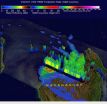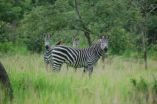(Press-News.org) VIDEO:
This 3-D simulated flyby of Tropical Cyclone Hellen on March 30, showed some powerful storms in Hellen's eye wall were reaching heights of over 13 km/8 miles.
Click here for more information.
When Tropical Cyclone Hellen was near the "peak of her career" NASA's TRMM satellite picked up on her popularity in terms of tropical rainfall. Hellen was a very heavy rainmaker in her heyday with heavy rain rates. Hellen weakened to a remnant low pressure area by April 1, but has now re-emerged in the Mozambique Channel.
Tropical Cyclone Hellen formed in the Mozambique Channel northwest of Madagascar on March 28, 2014. Hellen became a very powerful tropical cyclone with peak sustained winds of 130 knots/about 150 mph/241 kph on March 30, 2014. Hellen's eye came ashore in northwestern Madagascar on March 31 with winds predicted to be about 95 knots/109 mph/176 kph.
NASA and the Japan Aerospace Exploration Agency's Tropical Rainfall Measuring Mission satellite known as TRMM passed above Hellen on March 30, 2014 at 17:47 UTC/1:47 p.m. EDT when the tropical cyclone was close to peak power.
A TRMM rainfall analysis that was derived from TRMM's Microwave Imager (TMI) and Precipitation Radar (PR) data collected found that rain was falling at a rate of over 44 mm/1.7 inches per hour near the eye. Bands of moderate to heavy rain were shown moving over the northwestern coast of Madagascar.
TRMM PR data were collected at the same time in a swath that passed near the northern edge of tropical cyclone Hellen's eye wall. Those data were used to create a simulated 3-D view of Hellen's precipitation and also revealed that some powerful storms in Hellen's eye wall were reaching heights of over 13 km/8 miles.
Hellen seemed to run out of steam over Madagascar and the Joint Typhoon Warning Center issued the final warning on the tropical low pressure area on April 1 at 0300 UTC/March 31 at 11 p.m. EDT. AT that time, Hellen was centered near 17.0 south latitude and 46.1 east longitude, about 130 nautical miles/~150 miles/~241 km north-northwest of Antananarivo, Madagascar. Hellen was trudging to the south-southeast at 5 knots/5.7 mph/9.2 kph as it continued weakening.
Thirty minutes after the last warning from the JTWC, Hellen's remnants had moved back over water in the Mozambique Channel. The JTWC noted that because of favorable conditions such as warm water and low wind shear, the storm could regenerate in the next couple of days.
INFORMATION:
Text credit: Harold F. Pierce / Rob Gutro
SSAI/NASA Goddard Space Flight Center
NASA caught Tropical Cyclone Hellen's rainfall near peak
2014-04-01
ELSE PRESS RELEASES FROM THIS DATE:
Low sodium levels pre-transplant does not affect liver transplant recipient survival
2014-04-01
Researchers report that low levels of sodium, known as hyponatremia, prior to transplantation does not increase the risk of death following liver transplant. Full findings are published in Liver Transplantation, a journal of the American Association for the Study of Liver Diseases and the International Liver Transplantation Society.
Medical evidence shows that low sodium concentration is common in patients with end stage liver disease (ESLD), with roughly half of those with cirrhosis having sodium levels below the normal range of 135-145 mmol/L. Moreover, previous research ...
Study finds link between child's obesity and cognitive function
2014-04-01
URBANA, Ill. – A new University of Illinois study finds that obese children are slower than healthy-weight children to recognize when they have made an error and correct it. The research is the first to show that weight status not only affects how quickly children react to stimuli but also impacts the level of activity that occurs in the cerebral cortex during action monitoring.
"I like to explain action monitoring this way: when you're typing, you don't have to be looking at your keyboard or your screen to realize that you've made a keystroke error. That's because action ...
Misleading mineral may have resulted in overestimate of water in moon
2014-04-01
The amount of water present in the moon may have been overestimated by scientists studying the mineral apatite, says a team of researchers led by Jeremy Boyce of the UCLA Department of Earth, Planetary and Space Sciences.
Boyce and his colleagues created a computer model to accurately predict how apatite would have crystallized from cooling bodies of lunar magma early in the moon's history. Their simulations revealed that the unusually hydrogen-rich apatite crystals observed in many lunar rock samples may not have formed within a water-rich environment, as was originally ...
Monkey caloric restriction study shows big benefit; contradicts earlier study
2014-04-01
MADISON, Wis. – The latest results from a 25-year study of diet and aging in monkeys shows a significant reduction in mortality and in age-associated diseases among those with calorie-restricted diets. The study, begun at the University of Wisconsin-Madison in 1989, is one of two ongoing, long-term U.S. efforts to examine the effects of a reduced-calorie diet on nonhuman primates.
The study of 76 rhesus monkeys, reported Monday in Nature Communications, was performed at the Wisconsin National Primate Research Center in Madison. When they were 7 to 14 years of age, the ...
Wind energy: On the grid, off the checkerboard
2014-04-01
WASHINGTON D.C., April 1, 2014 -- As wind farms grow in importance across the globe as sources of clean, renewable energy, one key consideration in their construction is their physical design -- spacing and orienting individual turbines to maximize their efficiency and minimize any "wake effects," where the swooping blades of one reduces the energy in the wind available for the following turbine.
Optimally spacing turbines allows them to capture more wind, produce more power and increase revenue for the farm. Knowing this, designers in the industry typically apply simple ...
Scientists solve the riddle of zebras' stripes
2014-04-01
Why zebras have black and white stripes is a question that has intrigued scientists and spectators for centuries. A research team led by the University of California, Davis, has now examined this riddle systematically. Their answer is published April 1 in the online journal Nature Communications.
The scientists found that biting flies, including horseflies and tsetse flies, are the evolutionary driver for zebra's stripes. Experimental work had previously shown that such flies tend to avoid black-and-white striped surfaces, but many other hypotheses for zebra stripes have ...
Should family businesses always keep it in the family?
2014-04-01
Montreal, April 1, 2014 – From the Murdochs to the Hiltons, families have long sought to keep their businesses in the bloodline. But new research from Concordia University's John Molson School of Business shows that's not necessarily the best method of management.
The recent study, published in the journal Entrepreneurship Theory and Practice, shows that if the family business is part of a traditional industry built on quality and reputation, a family member would make a good CEO. But if it operates in an industry that values innovation, and the firm has to stay on the ...
The human 'hairless' gene identified: One form of baldness explained
2014-04-01
It's not a hair-brained idea: A new research report appearing in the April 2014 issue of The FASEB Journal explains why people with a rare balding condition called "atrichia with papular lesions" lose their hair, and it identifies a strategy for reversing this hair loss. Specifically the report shows for the first time that the "human hairless gene" imparts an essential role in hair biology by regulating a subset of other hair genes. This newly discovered molecular function likely explains why mutations in the hairless gene contribute to the pathogenesis of atrichia with ...
Breast milk and diet up to 2 years old: A means of preventing the risk of child obesity
2014-04-01
This news release is available in French. Many studies have focused on the influence of breast-feeding on child health. From analysis of data from the ELANCE cohort, Marie Françoise Rolland-Cachera, former researcher at Inserm and her co-workers in the Nutritional Epidemiology Research Team (EREN) have shown that breast-feeding has a protective effect on the risk of obesity at 20 years of age. Researchers also emphasise that nutritional intake at the age of 2 years are critical in providing this beneficial effect. The results of the study are published in The Journal ...
One currency, one price?
2014-04-01
Economics has a "law of one price," which states that identical goods should, in theory, sell for identical prices — or else markets will even out the differences. Empirical work on the topic, however, has produced little evidence in support of this "law," and many studies showing deviations from it.
Now a newly published paper co-authored by two MIT economists, along with a colleague from the University of Chicago, presents evidence of a strong convergence of prices within the Eurozone, the region of European countries sharing a common currency. The divergence of product ...





